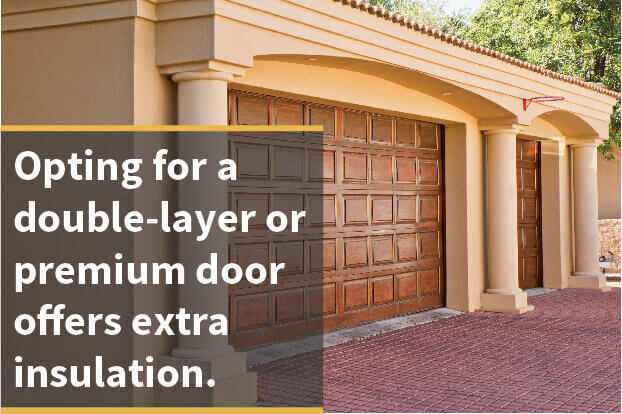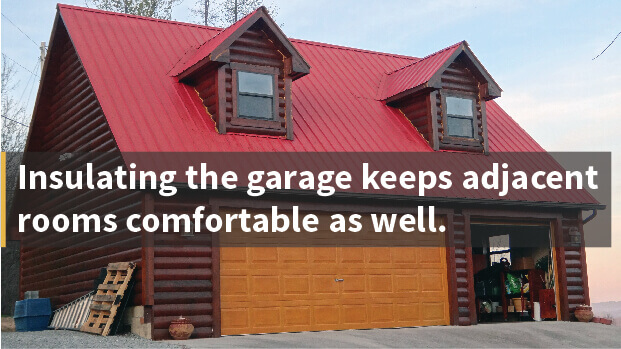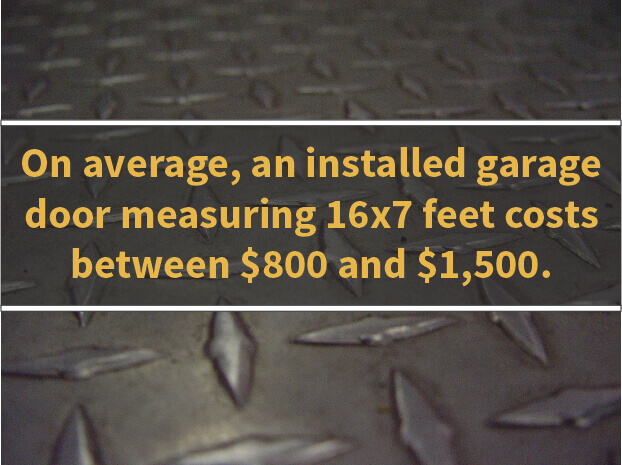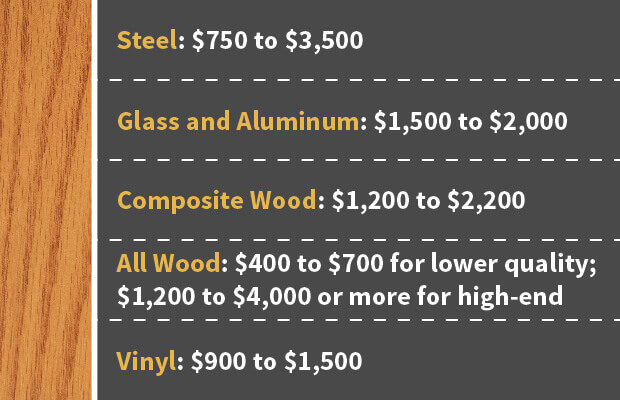How To Choose The Right Garage Door For Your Home
It’s time for a new garage door, but where do you start? Buying a garage door goes beyond good looks. Size, style, material, and insulation are just a few things to consider when replacing a garage door.

With a little know-how, you can navigate the types of garage doors and the distinguishing features to make your garage safe, well insulated and easy to access.
Selecting a Garage Door Dealer
Starting with a professional garage door dealer makes the entire process of selecting the right garage door much easier and less stressful.

Avoid an unprofessional or inexperienced dealer with these tips:
- Ask friends, neighbors and other local acquaintances for recommendations on garage door companies.
- Check the online reviews for the companies you’re considering. Look for a company with consistently positive reviews. Watch for red flags, including recurring issues that cause customer complaints. An occasional complaint or negative review happens sometimes, but a pattern of issues may be an indication you should choose another company.
- Find a company with years of experience in your area. This long-term experience means the company should understand the specific environmental factors in the area that can impact garage door selection. It’s also a sign the company provides good customer service — a company won’t last long by providing poor service.
- Check into the licensing and insurance the company holds. A reputable company carries commercial insurance coverage and follows all codes and regulations.
- Pay attention to the way the staff treats you. If they provide poor customer service when you’re initially gathering quotes, that quality of service won’t likely improve during the installation.
- Inquire about the services they provide. A quality company should help you through the entire process, from the initial consultation and selection process to installation and beyond.
- Ask lots of questions about garage doors and the installation process. Think of it as a pop quiz for the company. A reputable, qualified garage door dealer should have the knowledge to answer those questions thoroughly.
Choose a Material
The material selection affects not only the look of the door, but also the durability, cost and maintenance. The climate in your area affects the material choice as well.
Narrow down the garage door options by choosing the material that best fits your needs. Consider these primary garage door materials:
Wood
- Provides a classic, natural look
- Traditional styling ideal for Victorian or colonial homes
- Affordable material option
- Variety of wood choices for a custom look
- Choice of stained or painted finish for the style you want
- Option of wood veneers or overlays for lower cost
- Requires regular staining or painting to maintain appearance, making it more work
- Can expand and contract, causing warping and cracking without regular maintenance
Steel
- Strongest garage door material
- Available with embossing that looks like wood grain for a natural look without maintenance
- Stands up to weather elements without warping, cracking or falling apart
- Available finishes to prevent rusting
- Protective finishes to increase longevity of door
- Susceptible to dents
- Sometimes difficult to repair
- Occasional painting may be required, but not often, making it relatively low maintenance
- Opt for 24-gauge steel on a thick door rather than a thinner door with 28-gauge steel — a lower gauge number means stronger, more durable steel
Aluminum
- Made of frosted glass or fiberglass panels within an aluminum frame
- Translucent panels let in more light while still providing privacy
- Lightweight for less strain on the opener and tracks
- Little or no maintenance
- Won’t rust even in humid areas
- Contemporary look ideal for modern homes
- Available in a wide range of styles and colors for greater variety
- More likely to dent, crack or break, decreasing the life of the door
- Can yellow over time, leaving the door looking old or dirty
- Glass resists fading and yellowing more than fiberglass
- Poor insulator
Vinyl
- Lightweight for easy opening and less strain on your system
- No maintenance
- Affordable material
- No rotting or rusting, making it durable and long-lasting
- Resists dents to maintain like-new appearance
- Holds up in salty coastal areas
- Darker colors may fade, so choose a lighter color to keep up the look of the door
- Can look too much like plastic and lack curb appeal for some people — consider viewing the door in person before buying to make sure you like the look
Choose a Basic Type
Construction methods vary from low-end to premium doors. While low-end garage doors typically have only one layer, high-end doors have multiple layers.
Choose from these three basic garage door types:
- Single Layer: At the low end of the range, single-layer doors have only one layer of material. This keeps the cost low, but single-layer doors don’t offer much insulation.
- Double Layer: The next step up is a double-layer garage door with an inner core of polystyrene board for insulation and rigidity. That core is covered by a skin of the primary door material. Double-layer doors offer moderate insulation, usually with an insulating value of R-4 to R-7 — more on the R-value later.
- Premium: The top end of the spectrum consists of doors with a thick polystyrene or polyurethane insulation core with thicker outer layers on either side made of steel, wood or fiberglass. These thicker doors offer superior insulation with values of R-15 or higher.
Single layer doors save you money if the budget is the most important concern. You can find quality garage doors in all three types of garage doors, but opting for a double-layer or premium door offers the extra insulation many homeowners want.
Coordinate the Style and Color
Garage door styles range from simple and basic to intricately detailed doors that fit a particular architecture style. On many homes, the garage door takes up as much as 30 percent of the front façade, so choosing a style that works with your overall home style is important. Use the garage door selection as a way to add some character and style to your home’s exterior.
Take a step back to look at the front of your home. How does your current garage door fit into the overall style? Do you like the overall look, or are you ready for a change? What would you like to change about the style or color of the door to make it a better fit for the look of your home? Do you want the door to blend in with the home’s façade or stand out as a focal point of your home? These factors can help you narrow down the style options.
Possible Style Options
Panel design is one style factor on garage doors. Consider these basic types of garage door panels:
- Flush Panels: This type of garage panel is flat with some light texturing. Flush panel doors are basic and don’t draw a lot of attention. They are available with or without windows.
- Raised Panels: These garage doors feature panels with raised sections as a decorative element. The border around the raised section often has detailing for visual interest. Raised panels give the door depth and have a classic look. Choose between long raised panels, which run the width of the door and short raised panels, which are smaller with several short raised panels in a row.
- Carriage House Panels: An increasingly popular style, these doors look like old-fashioned carriage house doors. They often feature boards crossing at different angles to form the detailing. They may have two handles in the middle and large hinge-like detailing at the sides to look like real carriage house doors.
The style you choose should fit the general architectural style of your home. A Victorian or colonial home deserves a garage door with traditional styling that complements the existing architectural features. Wood construction or a door designed to look like wood creates that classic styling. Divided windows and decorative hardware also fit this style of home, as do the popular carriage-style doors. Avoid modern styles, which look out of place on classic homes.
If you live in a modern home, flex your design muscle with both material and detailing choices. Combining materials, such as wood and steel or aluminum and glass, often produces a modern style. Frosted or pebbled glass is also a fitting option, as is horizontal banding. Look for clean lines instead of ornate, intricate designs.
Ranch-style homes typically feature the classic raised panel style of garage door. Simple designs with horizontal elements work well.
Color enhances the styling of your new garage door and helps it either blend in with the façade or makes the garage door stand out as a decorative element. Choose a color that complements your home’s siding and trim colors. Matching the color to the home’s trim is one way to make the door blend in. White is a common color, but the bright color can make a stark contrast against red brick. A color that matches the mortar helps ease the transition.
If you’re not sure where to start or what would look good with your home, a garage door professional can help you get started. Look for a visualizing tool that lets you try different garage doors on a photo of your home. It’s easy to pick out doors you like in a showroom, but seeing it on your own home helps you find something you’ll love once it’s installed.
Consider Windows
Windows add architectural detailing to your new garage door and let in plenty of light, making your garage feel less like a cave. Most garage doors come with the option to add window panels with decorative frames.
Windows add to the cost of the garage door, but they also add detailing that sets your door apart. The window options come in a variety of shapes and styles, from basic rectangles to intricately detailed curved or starburst design windows. Just like the overall style of the door, choose windows that complement the other design elements on your home.
The placement of the windows is another design factor to tackle. Placement in the top panel adds the beauty of windows and still lets in the light while giving you some privacy in the garage. If you prefer to look out your garage windows, opt for placement in the third panel section up from the bottom of the door. This gives the windows height without making them difficult to reach.
If insulation is important for your garage door, opt for dual-glazed window panels instead of single-glazed panels.
Check Insulation
The garage may not be a living space, but insulation is an important consideration when choosing a new garage door, especially if you have an attached garage. Keeping the garage cool in the summer and warm in the winter can help keep adjacent rooms comfortable as well. Insulation also comes in handy if you use the garage as a workshop. A controlled temperature makes the space comfortable for working.
When evaluating a door’s insulation, look at the R-value, expressed as a number. A higher R-value provides greater insulating powers. A highly insulated garage door helps control temperature and minimizes sounds passing through the door.
Insulation typically comes in the form of a rigid polystyrene or polyurethane foam core between panels of the selected door material. The core makes the door lighter, especially if you opt for a steel door, making it easier and quieter to open and close.
While both materials offer insulating properties, polyurethane insulation generally has a higher R-value and is thinner than polystyrene. For this reason, overall thickness of the door isn’t the best way to determine the insulation quality. Instead, defer to the specs to see which door has a higher R-value.
Evaluate Safety Features
Your new garage door should not only increase your home’s curb appeal, but it should also make your home a safer place. Look for additional safety features when comparing garage doors.
Pinch-resistant doors prevent your fingers from getting smashed between the panels when the door closes. This feature is particularly useful if you have kids, but even adults appreciate it.
The cables that balance the garage door require a great deal of tension to work properly. Messing with that tension is very dangerous for an inexperienced person. Tamper-resistant bottom brackets ensure the tension remains steady by preventing the cables from loosening. These brackets require adjustment sometimes from a trained professional, and this is important as it could potentially prevent serious injury.
Lifestyle Factors
If you have kids, they play a role in choosing your idea garage door. No, you shouldn’t let your kids choose a garage door for you, but if they play in or near the garage, choose an option that stands up to them. A garage door with windows increases the likelihood of broken glass if your kids toss around balls in the driveway. Likewise, a material that dents or cracks easily, such as aluminum, quickly shows signs of wear if your child runs their bike into the door or tosses something at it.
Comparing Brands
The best garage door brands offer a wide range of styles with the quality craftsmanship to back it up. Using quality materials is a sure sign of a respectable garage door company. Positive reviews or designations by third-party organizations also help you spot the best brands.
Clopay® offers several lines of garage doors to fit a range of price points and styles. Consumer Digest named three of those lines — Classic Line Value Series, Classic Wood Collection Series and Reserve® Collection Limited Edition Series — as Best Buy options in August of 2012.
Clopay® aims to manufacture energy-efficient garage doors with low maintenance requirements, along with strength and beauty that make the doors a lasting part of your home. The company ranks as the largest North American garage door manufacturer for both residential and commercial doors.
Sawmill Creek offers custom garage doors in a wide range of styles made with quality woods and materials. The doors feature polystyrene insulation and construction methods that prevent rotting, so you don’t have to worry about deterioration of your new wood garage door. Best of all, the doors come with five and 10-year warranties, providing much longer coverage than many manufacturers.
Look for authorized dealers of the brands you are considering to ensure the quality and selection. For example, Custom Door & Gate is a Master Authorized Dealer for Clopay® garage doors, so we can offer lots of options.
Evaluate Cost
Like any home improvement project, it’s important to go into a garage door purchase with a budget in mind. On average, an installed garage door measuring 16 feet by seven feet costs between $800 and $1,500. On the low end of the range, you can get a composite wood door for around $400 and install it yourself to save money. If you want a custom high-end door, expect to pay $9,000 and up including installation.
The garage door material is one of the biggest factors in the pricing. Here are some general ranges based on material alone:
- Steel: $750 to $3,500
- Glass and Aluminum: $1,500 to $2,000
- Composite Wood: $1,200 to $2,200
- All Wood: $400 to $700 for lower quality; $1,200 to $4,000 or more for high-end
- Vinyl: $900 to $1,500
Several other factors go into the cost, including the detailing on the door. Windows and any extra detailing generally increase the cost, whether you choose a stock door or fully customize the door. Installation by a professional also pushes up the price by $250 to $500.
When pricing your new garage door, ask for a breakdown of costs in the estimate. This lets you see how much goes to the door, installation, automatic opener and any other costs.
Check out the Warranty
Warranties are standard for garage doors, but the length and terms of those warranties vary. Generally, a longer warranty indicates a higher quality door. If something does go wrong, you have the peace of mind knowing the warranty covers the problem.
Check the length of the warranty on each of the brands and styles you consider. Ask to see the fine print to ensure the warranty actually provides quality coverage should something go wrong with the door. A garage door may have a limited warranty with restrictions on what type of damage it covers.
Coordinate Installation
Installing a garage door requires at least two people with some knowledge of home improvement projects. The job comes with danger in the form of the heavy-duty springs that make the garage door function. The process involves mechanical aptitude and many small parts, along with managing the weight of a large garage door. For these reasons, most homeowners leave the garage door installation to the professionals.
Expect the installation to take about five hours — much faster than the average DIY installation. However, the job may take longer depending on the number of garage doors you have installed. Ask your garage door professional for a timeline of the project so you know what to expect.
Be sure to schedule the installation on a day when you don’t need access to the garage, so the installers can get the job done quickly. Professionals ensure the installation gets done properly with a balanced garage door that operates smoothly.
Choose Your Door
Now that you know how to buy a new garage door, check out the options we have available at Custom Door & Gate. Our garage door experts walk will you through the entire process, from selection to installation. We offer a wide range of choices from Clopay® and Sawmill Creek along with our Garage Door Visualizer, so you can find the perfect garage door that fits your style and needs. Contact us today.









